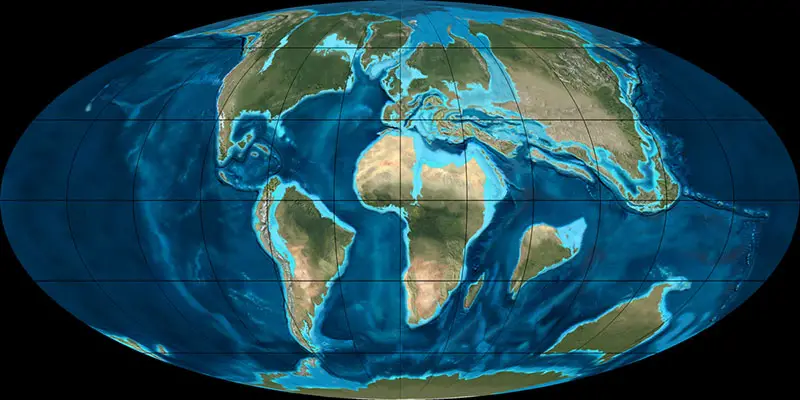†Palaechthon
Palaechthon ist eine Primatengattung, deren 4 Mitglieder ab dem frühen Paläogen (Paläozän) im Danium lebten, das vor ungefähr 66 Millionen Jahren begann und bis vor 61,6 Millionen Jahren andauerte. Viele Überreste wurden in Vereinigte Staaten von Amerika (USA) gefunden.
Zur Gattung Palaechthon gehören drei ausgestorbene Arten früher Primaten, die während des mittleren bis späten Paläozän in Nordamerika lebten.
Palaechthon alticuspis
Das Typusexemplar trägt die Bezeichnung U.S.N.M. no. 9532. Dabei handelt es sich um einen rechten Unterkiefer mit Prämolar und Molar (P2-M2). Der Fund stammt aus dem Gidley Steinbruch in Montana (Fort Union Formation) und dürfte zwischen 63,3 und 60,2 Millionen Jahre alt sein. Palaechthon alticuspis war vermutlich ein baumlebender Allesfresser, der sich mitunter auch von Insekten ernährte. Aufgrund der Größe und der Morphologie der Backezähne schätzen Wissenschaftler sein Körpergewicht auf 159,5 Gramm.
| Sammlung | Kommentar zum Fundort | Epoche, Alter | Geologie, Formation | Kommentar zur Sammlung |
|---|---|---|---|---|
| Halfway Hill Quarry | Hanna | Under the Maelstrom; UW V-94041 | ||
| Kommentar z. Stratigraphie | Kommentar z. Taxonomie | |||
| said to be late Torrejonian to early Tiffanian | probably includes material from UW V-94048 |
Palaechthon torrejonius
Das Typusexemplar mit der Bezeichnung UKMNH 7903 ist ein rechtes Oberkieferfragment mit Prämolar und Molar. Der Fund stammt aus der Nacimiento Formation New Mexicos und ist zwischen 63,3 und 60,2 Millionen Jahre alt. Palaechthon torrejonius war ein Allesfresser.
| Sammlung | Kommentar zum Fundort | Epoche, Alter | Geologie, Formation | Kommentar zur Sammlung |
|---|---|---|---|---|
| Big Pocket | Nacimiento | Angels Peak; KUVP Loc. 13; Locality NM 13; NMMNH 2635; UALP 7435, 7436, 75144; NMMNH locality L-2635 | ||
| Kommentar z. Stratigraphie | Lithographie | Kommentar z. Taxonomie | ||
| from "a zone... three to four feet in thickness... The actual bone layer, not as yet located, may prove to be thinner than this" (Wilson 1951) not far below the middle of a reversed magnetic polarity zone in the Kutz Canyon section interpreted as C27r based on the position of the K-T boundary in the correlative Barrel Spring Arroyo = De-na-zin Wash section: see Butler et al. 1977, Lucas et al. 1997 | "reddish silt" (Wilson 1951) | UALP localities are at exactly the same level as KUVP 13 but may be at some distance\r\nfollowing taxa listed by Williamson and Lucas may be from Big Pocket or a stratigraphically nearby locality: ? Peradectes sp. "D" Pentacodon inversus Protictis haydenianus "Protictis" sp. "A" Protictis (Protictis) sp. "B" Triisodon quivirensis Ellipsodon inaequidens |
| Physiologie | |
|---|---|
| Gewicht: | ? |
| Schwestertaxa | |
Palaechthon woodi
Das Typusexemplar ist ein Unterkiefer mit der Bezeichnung MCZ 18740. Palaechthon woodi war ein baumlebender Allesfresser. Basierend auf der Größe seiner Backenzähne schätzt man das Gewicht dieses kleinen Säugetiers auf 93,5 Gramm.
| Sammlung | Kommentar zum Fundort | Epoche, Alter | Geologie, Formation | Kommentar zur Sammlung |
|---|---|---|---|---|
| Big Pocket | Nacimiento | Angels Peak; KUVP Loc. 13; Locality NM 13; NMMNH 2635; UALP 7435, 7436, 75144; NMMNH locality L-2635 | ||
| Kommentar z. Stratigraphie | Lithographie | Kommentar z. Taxonomie | ||
| from "a zone... three to four feet in thickness... The actual bone layer, not as yet located, may prove to be thinner than this" (Wilson 1951) not far below the middle of a reversed magnetic polarity zone in the Kutz Canyon section interpreted as C27r based on the position of the K-T boundary in the correlative Barrel Spring Arroyo = De-na-zin Wash section: see Butler et al. 1977, Lucas et al. 1997 | "reddish silt" (Wilson 1951) | UALP localities are at exactly the same level as KUVP 13 but may be at some distance\r\nfollowing taxa listed by Williamson and Lucas may be from Big Pocket or a stratigraphically nearby locality: ? Peradectes sp. "D" Pentacodon inversus Protictis haydenianus "Protictis" sp. "A" Protictis (Protictis) sp. "B" Triisodon quivirensis Ellipsodon inaequidens |
Literatur
G. G. Simpson 1937, The Fort Union of the Crazy Mountain field, Montana and its mammalian faunas. Bulletin of the United States National Museum. 169, p. 1 - 287K. D. Rose 1981, The Clarkforkian Land-Mammal Age and Mammalian Faunal Composition Across the Paleocene-Eocene Boundary. University of Michigan Papers on Paleontology. 26, p. 1 - 197
G. F. Gunnell 1989, Evolutionary History of Microsyopoidea (Mammalia, ?Primates) and the Relationship Between Plesiadapiformes and Primates. University of Michigan Papers on Paleontology. 27, p. 1 - 157
T. E. Williamson, S. G. Lucas 1993, Paleocene vertebrate paleontology of the San Juan Basin, New Mexico. New Mexico Museum of Natural History Bulletin. 2, p. 105 - 136
L. M. Van Valen, S. G. Lucas 1994, The origin of the plesiadapid primates and the nature of Purgatorius. Evolutionary Monographs. 15, p. 1 - 79
T. E. Williamson, S. G. Lucas 1996, The beginning of the age of mammals in the San Juan Basin, New Mexico; biostratigraphy and evolution of Paleocene mammals of the Nacimiento Formation. New Mexico Museum of Natural History and Science Bulletin. 8, p. 1 - 141
R. Secord, S. G. Lucas 1998, Paleocene mammalian biostratigraphy of the Carbon Basin, southeastern Wyoming, and age constraints on local phases of tectonism. Rocky Mountain Geology. 33:1, p. 119 - 154, DOI: 10.2113/33.1.119
